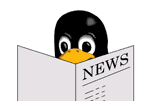

 |  |
|
|
X11-big-cursor MINIHOWTOHow to use enlarged mouse cursors with the X window systemJörg Schneiderv2, 11 August 1997This document describes how to use enlarged mouse cursors with the X window system.
1. Introduction
2. About this document
3. How to do it
4. Notes and limitations
5. Technical discussion
6. Other ideas how to make the mouse cursor more visible
7. Related info1. IntroductionThere are several reasons why the standard X mouse cursors are hard to track for some people:
In all cases it might help to use enlarged mouse cursors. Ideally this job should be done by a single X program that automatically enlarges every mouse cursor. To my knowledge there is no simple way to write a utility like this, because the X protocol has no provision to query mouse cursors. For more details see section Technical discussion below. If we aim for a less general goal, though, something can be done: There is a set of standard mouse cursors that can be found in the
cursor font (try
2. About this documentThe motivation for this MINIHOWTO was a visually impaired co-student who asked me how to enlarge the mouse cursor under X. After I found out how this can be done, I wrote an initial version of this document. The knowledge about the method described here does not seem to be common, so I decided to share it and submitted this document as a Linux MINIHOWTO, despite the fact that it is not specific to Linux at all. As all other MINIHOWTOs it can be found in the home of of the Linux Documentation Project (LDP). The master of this document is maintained in the SGML/linuxdoc format. This makes it possible to automatically provide versions in the following formats (which can be found in the same place as the master): html, text, LaTeX, DVI, PostScript, GNU info. Shinobu Miyata has done a Japanese translation of this MINIHOWTO. It can be found in http://i11www.ira.uka.de/~schneid/jp/X11-big-cursor/.
3. How to do itFollow the steps detailed below. If you don't want to get and compile the bdfresize package yourself, you can skip to step 3 and download a magnified font instead of creating it.
That's it—now all mouse cursors should have doubled in size.
4. Notes and limitations
5. Technical discussionIs it possible to write a X program that enlarges cursors automatically?
6. Other ideas how to make the mouse cursor more visibleHere are some ideas for rather simple X programs that might make mouse cursors easier to track.
A more demanding project would be mouse trails à la windoze, i. e. when the mouse is moved and the mouse cursor needs to be drawn in a different position, then the old mouse cursor does not disappear at once, but after a short delay. Mouse trails would be probably best implemented in a X server, but it might be feasible to do it as a X client, or better as a proxy server (see section Technical discussion for details).
7. Related info7.1 How to use a font serverA font server is a net service that provides a set of X11 fonts with a simple protocol. It can be queried which fonts it provides and will supply the font bitmap data on request. You might want to use a font server to provide the X server with a modified cursor font, instead of telling it where to find the font on the file system. This method is especially handy if you use several machines that don't share a common file system or if you use X terminals that support the font server protocol. A font server program and associated tools comes with the X11R5+ distribution (AFAIK).
Setting up a font serverRead the manual pages fs(1), fslsfonts(1) (or
xfs(1), xfslsfonts(1) under X11R6) and try it—it isn't
hard. Say, you are running the server on host
To actually use the server issue the command
which should return without an error message.
7.2 How to get the bdf source for some fontIf you have set up a font server simply use Alternatively you may try
|

|